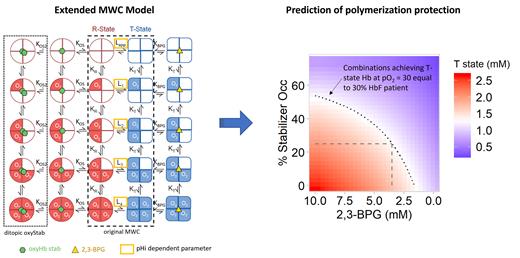In sickle cell disease (SCD) red blood cell sickling is driven by concentration dependent polymerization of mutation-carrying deoxygenated hemoglobin (deoxHbS). Multiple treatment strategies aim to reduce the concentration of deoxHbS to prevent sickling. Evidence for the utility of this approach is seen in patients endogenously expressing >30% HbF who are largely asymptomatic. In addition to inducing HbF, two other strategies, stabilizing oxygenated hemoglobin (oxyHbS) and lowering 2,3-BPG similarly aim to reduce deoxHbS. However, the degree of oxyHbS stabilization or 2,3-BPG lowering needed to achieve a similar reduction in deoxHbS as 30% HbF is not known. Furthermore, it may not be possible to reach the desired efficacy by a single therapeutic agent making it important to understand how these mechanisms would perform in combination. To address these questions, we extended the Monod-Wymann-Changeux (MWC) oxygen saturation model to include hemoglobin binding to 2,3-BPG and oxyHbS stabilizers and added an additional species to represent HbF. It was assumed that oxyHbS stabilizer occupancy provided equivalent polymerization protection as HbF, which may not be true for all molecules in this class. The model allows simulation of varying levels of oxyHbS stabilizer occupancy, 2,3-BPG lowering, or HbF intervention alone or in combination to calculate the deoxHbS concentration at oxygen tensions found in peripheral tissue and assess polymerization protection. By this approach, the model predicts 51% occupancy by an oxyHbS stabilizer or reduction of 2,3-BPG to 1.8 mM will give equivalent polymerization protection as 30% HbF. Simulations indicate combining any two mechanisms results in a further decrease in deoxHbS compared to either mechanism alone, suggesting combination therapy will have added benefit in the case of dose limitations. By including the main strategies aimed at reducing deoxHbS, this model represents a unified framework that is useful in supporting decisions across the R&D continuum and can be adapted as new clinical data becomes available to gain new and increasingly confident insights into treatment strategies for SCD patients.
Disclosures
Moody:Pfizer Inc: Current Employment, Current equity holder in publicly-traded company, Current holder of stock options in a privately-held company. Maurer:Pfizer Inc.: Current Employment, Current equity holder in publicly-traded company, Current holder of stock options in a privately-held company. Narula:Pfizer Inc: Current Employment, Current equity holder in publicly-traded company, Current holder of stock options in a privately-held company.


This feature is available to Subscribers Only
Sign In or Create an Account Close Modal